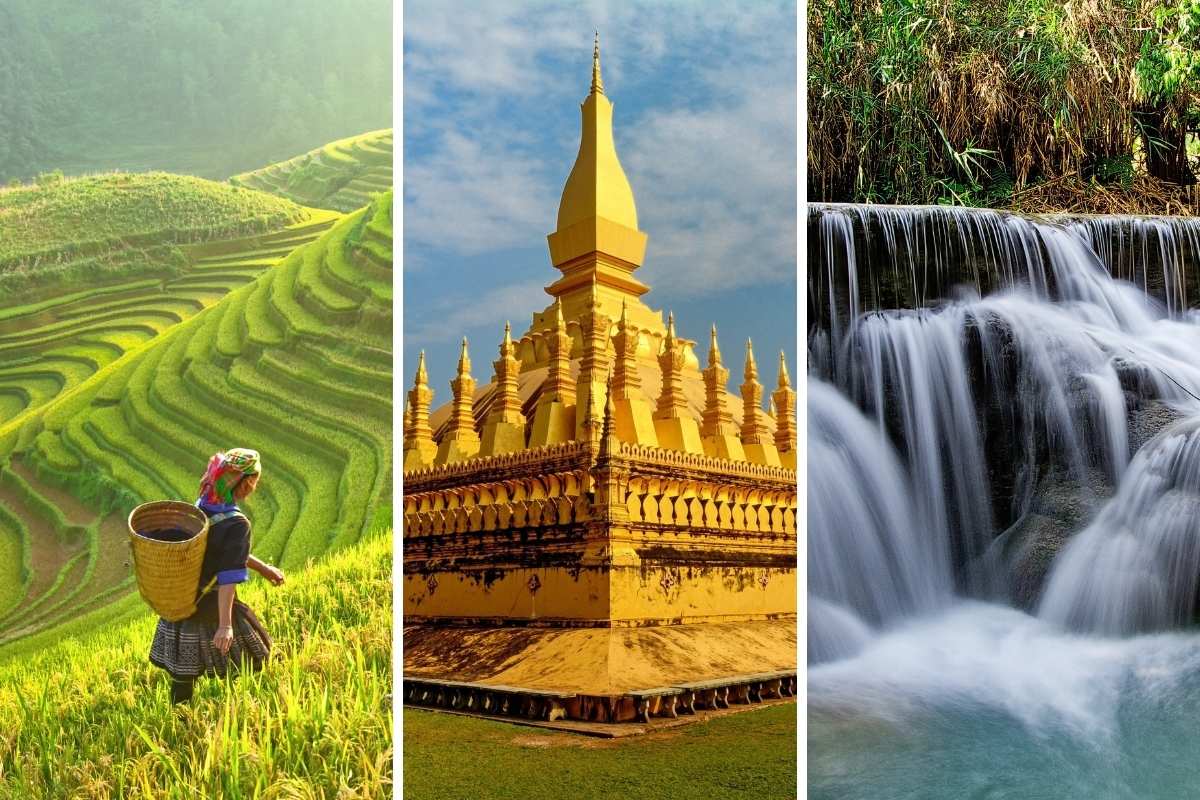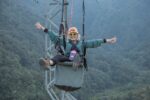A trip to Laos is nothing short of a meditative experience. Life moves mindfully, the cuisine is soulful and the ambience is pure bliss. Temples, caves, forests, waterfalls, mountains, and adventure sports are some of the unique features of a holiday in Laos. The country has a wild terrain which is home to around 49 ethnic groups.
Since the climate is tropical throughout the year Laos can be visited anytime. However, a river cruise is possible when the water levels are higher, so the period between November – January is apt. Here are some of the most incredible places to visit in Laos on your trip.
Discover Vientiane

Vientiane – Laos’ is somewhere between a big town and a diminutive city; the kind of place you might expect to encounter a Graham Greene protagonist.
Even though it is the capital of Laos, this city still has a small-town feel, which is one of the many things tourists appreciate about it.
It has a relaxed atmosphere and a decidedly French ambiance, thanks to Laos being a French colony at one time.
In addition to a Buddha park and several temples, the city is also home to a beautiful boulevard with restaurants, cafes, and an extraordinary night market, not to mention a unique flair that makes this one city you won’t want to miss.
Live like a Parisian in the capital

Patuxai is a war monument dedicated to those who fought in the struggle for independence from France
Formerly a French colony, charming Vientiane is South-East Asia’s answer to Paris. Visit Laos’ own Arc de Triomphe (Patuxai), built with concrete given to them by the USA for a new airport runway. Wander up the commercial district for a view of ‘the vertical runway’ before climbing to the top for stunning views over Vientiane.
Descend the monument and continue to Pha That Luang. Said to be the most important national monument in Laos, this gold-leafed temple is believed to have a piece of Buddha’s breastbone encased in the stupa.
For an insight into the tragic history, visit the COPE centre. More bombs were dropped on Laos per capita during the Vietnam War than any other country in history. Many bombs failed to detonate, and still injure Laotians today, hence the importance of COPE. This organisation educates visitors on the problem, and provides victims with prosthetic limbs and rehabilitation.
Lose yourself in Luang Prabang’s temples

Cobbled streets, saffron-robed monks, mile-long markets, and a riverfront with stunning sunsets backed by magnificent karst scenery. It’s hard not to feel peaceful in spiritual Luang Prabang. With 33 wats in this sleepy city, you could spend days just exploring the temples alone.
Rise at 5am to watch tak bat, where Buddhist monks walk the streets for the morning alms giving. Climb Mount Phu Si for 360-degree views over Luang Prabang. Walk around the back of the mountain to find giant Buddhas etched into the cliffs.
Peep at Wat Mai Suwannaphumaham before walking towards Sakkarin road marvelling at the many temples lining the street every 100 metres or so. Soon you’ll reach the sacred spot where the Mekong and Nam Khan rivers meet.
Here you’ll find Wat Xieng Thong, the city’s most awe-inspiring temple with its layered roof just shy of touching the floor and a mosaic-encrusted back wall displaying the tree of life – and that’s before you’ve even set eyes on the rare reclining Luang Prabang-style Buddha inside.
Have an adventure in Vang Vieng

Hidden among green-carpeted karsts and pockets of jungle, ruggedly beautiful Vang Vieng is no longer the party town that gave it its bad reputation, but a lot of fun can still be had here. For full-on adventure, kayak down the Nam Song at white-water rafting speeds.
Pull up at the river’s edge and swap paddles for a harness for a zipline experience taking you above the tree-tops, finishing with a steep descent that makes you certain you’ll plunge into the river below.
If you prefer being underground to flying through the air, explore Vang Vieng’s best caves. Tham Xang (Elephant Cave) is home to ancient Buddha statues, a Buddha footprint and an elephant-shaped stalactite. Tham Hoi and Tham Loup also house Buddha statues along with the names of 100 people who hid in the cave during the wars. To explore Tham Nam (Water Cave), jump in a rubber ring and tube through the dark, water-filled cave with only a headtorch and rope for guidance.
Drown in history at Vieng Xai’s caves

Despite suffering heavy bombardment at the hands of the USA, Vieng Xai, a valley of verdant hills, quaint houses and manmade lakes, is astonishingly beautiful. Of the hundreds of caves in the district, only seven are open to visitors. But even this small handful will give you a unique insight into war-time Laos.
This is no ordinary cave trip. These rock shelters which were inhabited by civilians and politicians during the nine years of war are more like an intricate network of museums.
The old living quarters haven’t changed much, and with tour guides and audio guides available, it’s a real opportunity to see for yourself just how big a role the caves played during the war.
Trek your way through Phongsali

If you thought you didn’t need to pack a coat for Laos, think again. At an altitude of 1,626m, mountainous Phongsali gets cold, but it’s worth bracing it for the splendid panoramic views. The cloud-cladded mountains and a vast, verdant jungle are just some of the reasons this region is Laos’ go-to trekking spot. Trekking tours include hikes up mountains with forest views, staying with the unique Akha Puxo people and descending into a valley to see rice paddies sprawl out around you.
Due to China’s influence on Phongsali, the architecture is fascinating, with buildings fluctuating between industrial Chinese concrete blocks to tin-roofed houses and mud huts.
To feel like you’ve travelled to China, visit the Yunnanese shophouses and the Chinese temple. For a history of Phongsali, head to the Museum of Tribes to find information, photos and colourful costumes.
Soak up the waterfalls in Si Phan Don

Head south to Si Phan Don, an archipelago of islands which is home to the Mekong’s most magnificent waterfall, Khon Phapheng Falls. With the cascading water crashing and frothing over the rocks, it’s no surprise it’s called the Niagara of Asia.
Go early to catch a glimpse of a rainbow on the mist and to avoid the worst of the huge crowds that gather here.
For a cheaper and quieter experience, head to Don Khon to find the fast-flowing rapids of Tat Somphamit cutting paths into the rocks it runs along. Also known as ‘Spirit Trap’, locals believe the falls wash bad spirits down the river.
Watch the water flowing as you eat at the nearby restaurant or go to Tay Somphamit beach for a safe swim. Another quieter but still impressive option is Khon Pa Soi Falls. Walk along the suspension bridge to Don Po Soi island for the best views of the waterfall.
Monkey around in Huay Xai

If spending your nights sleeping in sky-high treehouses alongside gibbons, and days ziplining from tree to tree is your idea of jungle heaven, then you’re in luck.
In Huay Xai, near the border with Thailand is the Gibbon Experience. Based deep in the Bokeo Nature Reserve, the experience offers visitors the chance to spend three nights in the treehouses.
Spend your mornings with the guides gibbon-spotting, seeing other wildlife such as giant squirrels and Asiatic black bears. Or you can choose a three-day option, trekking for around three hours each day along the Nam Nga River passing a fresh water swimming pool and a waterfall. One of the treehouses you’ll bunk down in overnight offers stunning sunsets across the valley.
Visit Golden Buddha

When in Pakse, it’s hard not to notice the giant golden Buddha that overlooks the Mekong River. As you make your way up the hill to the Buddha, you’ll notice many other statues along the way, including the Snake God statue that guards and protects the Buddha statue.
To reach the Buddha, you’ll need to cross Nippon Bridge from Pakse by foot, bike, or taxi. You’ll find the giant Buddha perched on top of a lotus flower facing the Mekong River and the city center that lays across from it.
It’s a stunning sight to see at any time of the day, although sunrise and sunset are guaranteed to be even more breathtaking.
Explore Si phan Don

The 4000 Islands, also known as Si Phan Don, is a riverine archipelago located in the Mekong River in the Champasak region in the southern part of Laos. This area is characterized by many small islands scattered throughout the section of the Mekong that stretches over 14 kilometers. They were formed naturally over time due to the erosion and sedimentary processes of the Mekong River.
The Mekong is one of the world’s major rivers, flowing from the Tibetan Plateau through China’s Yunnan province, Myanmar, Laos, Thailand, Cambodia, and Vietnam. As the river approaches the Cambodian border, the massive volume of water, along with the geological features of the region, contributes to the continual creation and reformation of islands. Changes in water level, particularly during the rainy and dry seasons, can dramatically alter the landscape; some islands disappear under water during the wet season, while others emerge as the water level drops.
The islands’ creation is a natural process resulting from the dynamic interaction between the river’s flow and its bed, causing the deposition of sediments in some places and erosion in others. Moreover, each island varies in size and habitability; some are home to small communities and have developed infrastructure, while others are tiny and uninhabited, often little more than sandbars.
This part of Laos is known for its serenity and natural beauty, drawing visitors interested in exploring its unique riverine environment, which also includes the rare Irrawaddy dolphins and the largest waterfall in Southeast Asia by volume, Khone Phapheng Falls.
Sit on the Vang Vieng Balloon

If you’re searching for an unforgettable experience, a Hot Air Balloon ride in Vang Vieng should be the first thing that comes to mind! Explore Vang Vieng from above in a Hot Air Balloon, one of the most popular activities in Vang Vieng that will take your experience of exploring Vang Vieng to a whole new level.
Hot air balloon rides are among the most distinctive and memorable experiences available. Floating through the skies in a Hot Air Balloon is an experience you will never forget!
Visit Vat Phou

Vat Phou joined the UNESCO World Heritage List in 2001. The temple can be visited at any time of the year, but visiting during the festival season (on the full moon of the third lunar month) is highly recommended.
Translated to “mountain temple” in English, Vat Phou is the name for the ruins of a Khmer Hindu temple that dates back to the fifth century, but don’t let the description fool you.
It is exciting to view, but the mountaintop that holds the ruins is lush and green and dotted with occasional flowers.
One of the many things that makes the ruins interesting is that you can still see the inscriptions and the altars that were there a thousand years ago, making it a fantastic place for history buffs to visit.
The World Is Huge. Don’t Miss Any Of It























